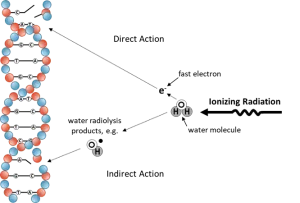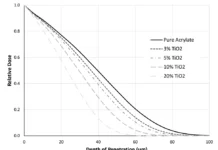
Electron beam has been used to cure coatings and cross-link films, but did you know that it can sterilize, too? Radiation-based bioburden reduction and sterilization methods have been used commercially for several decades.1 Including gamma, x-ray, and electron beam, these methods work by harnessing ionizing radiation to break bonds within microbial DNA, thus inactivating the microorganisms (Figure 1).2,3 These processes are chemical-free with a relatively small temperature increase and no post-process quarantine, which can give radiation an advantage over other sterilization techniques, such as ethylene oxide and steam.
Traditionally, low-energy EB (≤ 300 kV) has not been a big player in the bioburden reduction/sterilization market. Most often, goods are shipped to facilities operating gamma, high-energy x-ray and/or high-energy EB (≤ 10 MV), and, because of the penetration abilities of these technologies, are irradiated in boxes or even as a palletized unit. Imagine how many thousands of surgical gloves can fit on a single pallet! In comparison, low-energy EB is regarded as only a surface sterilization method. While it is true that it has a much more limited ability to penetrate into matter, there are advantages that make it worth a second look for some applications.
One of the reasons sterilization contract facilities exist is because of the high cost of the equipment and infrastructure needed for operation. With more material penetration comes more radiation shielding; these high-energy technologies require a specially designed concrete labyrinth structure as opposed to the self-shielding needed by low-energy EBs.1,4 Gamma facilities also require a radioactive source (Co60), which has caused them to be looked on less favorably in recent years. Overall, low-energy EB offers the advantages of in-house processing and scheduling control, elimination of a transportation step and the associated greenhouse emissions, and flexibility in the machine design to meet production needs.
When deciding what radiation method is right for a process, an important metric to keep front of mind is the dose uniformity ratio (DUR).1 In radiation processing for bioburden reduction and sterilization, the goal is to minimize the DUR (aka energy distribution) through the product. Consider, if a process has a DUR of 2, to ensure a minimum dose of 25 kGy throughout the product this means other areas of the product will receive as dose as high as 50 kGy. Changes in the material properties of the product or product packaging – cross-linking, degradation, color change, etc. – can be more pronounced at 50 kGy than at 25 kGy, and an inconsistency in these material properties throughout the product can be problematic. Additionally, the FDA has regulated the maximum dose some foods can receive, and so a low DUR is important to staying below the max dose threshold while still ensuring an adequate minimum dose is reached for safe consumption. Achieving a low DUR also can be critical in other applications where property consistency is of concern, such as with coatings and adhesives; however, the terminology often is not applied to the more traditional low-energy EB product areas, likely due to the relatively thin treatment layer and mostly single-sided exposure.
Deciding which applications might benefit from low-energy EB bioburden reduction or sterilization requires a bit of out-of-the-box thinking – quite literally, as low-energy EB is not going to penetrate most boxes! – and exploring some of the base assumptions of the technology. To start, if the process is for surface sterilization, what’s wrong with just sticking to the surface? In some cases, such as the treatment of seeds, the lack of radiation penetration is exactly what is needed to decontaminate the surface while also not causing any undue damage to the inner layers.5
Furthermore, how thick is a surface? At 300 kV, an electron beam can deliver a fairly uniform dose through a unit-density material ~400-µm thick. Such a thickness may truly be considered just the surface to something like a cardboard box, but, in the flexible packaging industry, 400 µm could penetrate several layers of film. Need to sterilize the inside of a plastic pouch? Low-energy EB could be the right fit. Product density is less than 1? Low-energy EB can penetrate even farther!6 Of course, the reverse also is true, meaning dense materials likely are not a good fit, unless looking to keep the microbial mitigation to the material surface.
In another bout of semantics: Does the product actually need to be sterilized? Sometimes, sterilized is used broadly, and not every application requires the product to be completely “free of living organisms.”7 Products that fall short of being completely sterilized still may require a form of bioburden reduction or disinfestation. The distinction in definitions can be very important to how low-energy EB may be implemented. For example, given an adequate dose (typically ~25 kGy), the surface of every film that is passed under an EB – whether to cross-link the film or cure an ink – momentarily is sterile, but unless the beam is housed in an aseptic area, microbes in the air immediately re-contaminate the film surface. High-energy technologies don’t face this consideration as all products are packaged before irradiation. Similarly, sterility can be maintained if the accelerated electrons reach into a sealed area, such as the inside of a pouch. Yet, if sterility is not the goal, but, say, the inactivation of salmonella and E. coli on spices5, then an aseptic or sealed-in area is not required.
If out of the box is the best way to utilize low-energy EB, it begs the question: At what point in the production process can bioburden reduction or sterilization occur? High-energy technologies may limit how many products can be processed in a single box or pallet, but the discussion almost always is focused on the completed product. With low-energy EB, processing might need to take place well upstream. Instead of processing a shipping box filled with individual containers of individually-wrapped bandages, for example, you may be restricted to irradiating the bandages before they are packaged into their individual containers to get an appropriate DUR.
Even out of the box, some creativity maybe required for how the product is handled and/or the electron beam is constructed to ensure the needed surfaces are exposed and a low DUR is achieved. It may be as simple as flipping the product to expose both sides to the beam, or it may require a more complex system with free-falling product between two, inward-facing EB emitters.5,8 In either case, a low-energy EB system can be customized to the process. Additionally, dosimeters can be used to confirm the dose distribution is satisfactory on different product surfaces and layers.
To conclude, don’t forget low-energy electron beam when considering radiation processing for the bioburden reduction or sterilization step. It might not always be the obvious solution, but for the right application, the advantages of low-energy EB can outweigh a little extra work upfront and successfully make in-house radiation processing a possibility.
References
- Trends in Radiation Sterilization of Health Care Products, IAEA, 2008. https://www-pub.iaea.org/MTCD/publications/PDF/Pub1313_web.pdf
- Hall, E.J., Giaccia, E., Editors, Radiobiology for the Radiologist, 6th ed., 2006.
- Radiation Biology: A Handbook for Teachers and Students, IAEA, 2010. https://www-pub.iaea.org/mtcd/publications/pdf/tcs-42_web.pdf
- Schissel, S.M., Radiation Safety for Electron Beams, UV+EB Technology, (3) 2021.
- Laatu: Non-thermal, in-plant microbial reduction solution for dry foods. Buhler, 2019. https://www.buhlergroup.com/content/buhlergroup/global/en/services/Digital-services/laatu.html
- Schissel, S.M., EB Operation 101, UV+EB Technology, (1) 2021.
- Sterile, Merriam Webster.
- Schissel, S.M., EB in 3D?, UV+EB Technology, (4) 2020.
 Sage Schissel, Ph.D.
Sage Schissel, Ph.D.
Applications Specialist
PCT Ebeam and Integration LLC
sage.schissel@pctebi.com





